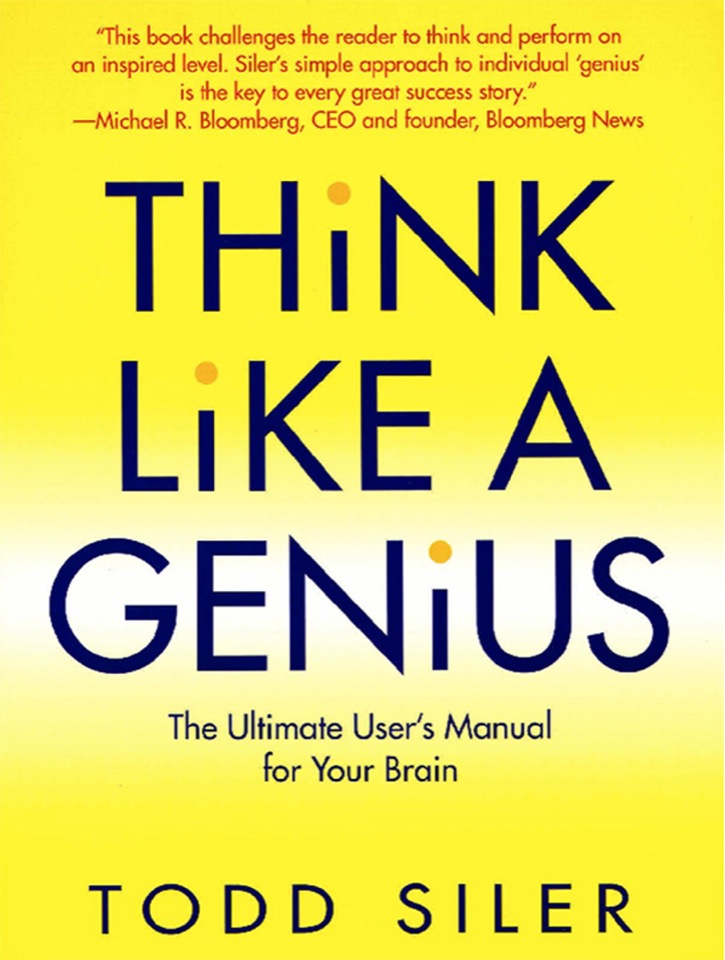
“Siler's approach is simple, practical, fun, and most importantly, highly productive.”
— Peter M. Senge, author of The Fifth Discipline
“Think Like a Genius is an excellent and practical guide for anyone who wishes to become more original in their thinking and to use creativity more effectively.”
— Daniel L. Ritchie, Chancellor, University of Denver
“An ingenious and useful tool for enhancing everyone’s creative thinking.”
— Mihaly Csikszentmihalyi, author of Flow and Creativity
“These are insights of a genius into the methods of all genius. Todd Siler convinces us, with a breezy, easy-to-digest profundity, that we plain folks can apply these methods to free us to be the best we can be. That's ingenious.”
— Larry Merchant, television commentator and author
“Read this book. Todd Siler has a great deal to teach all of us about the barriers to creativity and ways of overcoming them.”
— Stephan L. Chorover, Ph.D., professor of Brain and Cognitive Sciences, Massachusetts Institute of Technology
“Todd Siler gives us all the tools to be creators, not just in our lives, but of a vision worth striving for.”
— Jenette Kahn, president and editor-in-chief, DC Comics/Time Warner
”Genius is everywhere, everyday, in everyone, in everyway imaginable!“ — Todd Siler
This timeless guidebook teaches you the essential steps to tapping your creative potential, imagination and knowledge everyday, in order to meet your urgent challenges, solve your most pressing problems and achieve your goals. Essentially, it helps you think, create and perform at your highest level anywhere, anytime.
The four-step Think Like A Genius process enables you to discover and apply your innate abilities to connect and transform information and ideas in productive ways; to make discoveries and insights based on these connections; to constantly innovate; and to apply your innovations with remarkable results.
Published in eight foreign languages, Think Like A Genius is being used by leading businesses, schools, entrepreneurs, inventors, and innovators worldwide to stimulate creativity and catalyze innovation.
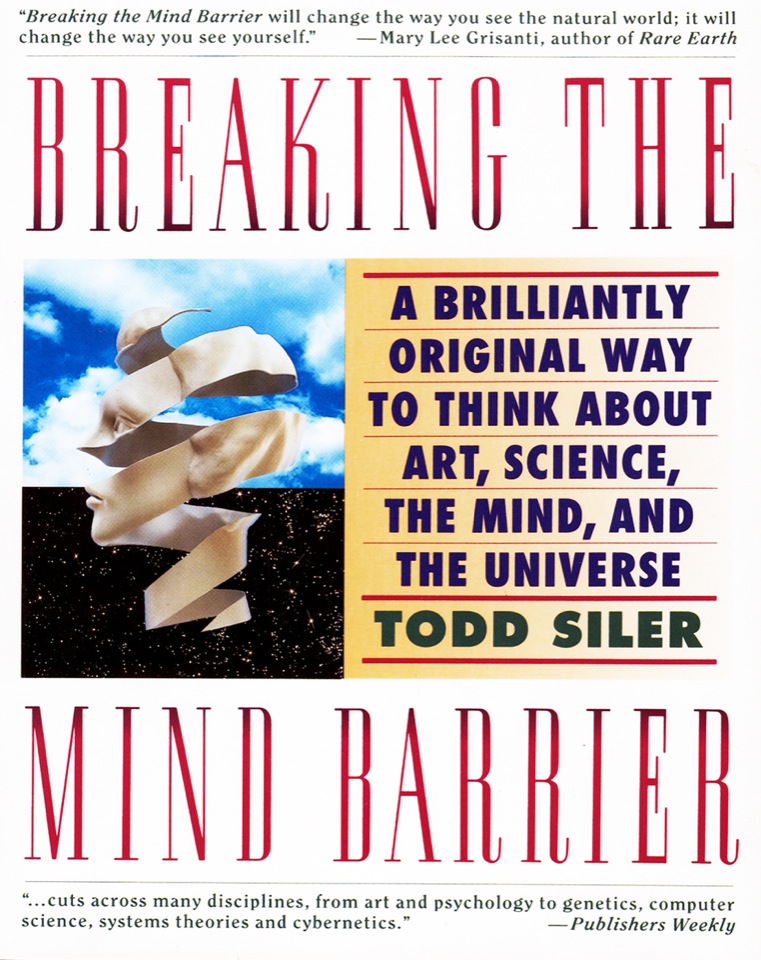
“Drawing on a range of disciplines from art to Zen Buddhism and brain science to physics, Todd Siler, author of Think Like a Genius, explores how we decode the universe by decoding the brain—and vice versa. Using his internationally acclaimed artworks, he shows how the things we create, from art to science to simple tools, are reflections of the brain—while the brain is a reflection of the larger universe. Lively and original, Breaking the Mind Barrier is a must read for anyone interested in the origins of Siler’s pioneering work and will intrigue readers seeking a better understanding of the deep connections between mind and matter.” — Publisher's Weekly
"This is a work of astonishing ambition and range by an artist-scientist who undertakes no less than to find in contemporary scientific theories grounds for indentifying the functioning of our brains and nervous system with the function of the cosmos and the laws of physics. In a sense, Siler aixm to achieve for our day what Alexander von Humboldt, in Cosmos, 1845, did for his. Humboldt sought to confirm the guiding hand of God. Siler does not nmke the claim, but he gives some pretty good evidence." — Dr. James Ackerman, Arthur Kingsley Professor of Fine Arts, Harvard University
"Todd Siler is an exceptionally gifted young man of many parts. This is a work of rare genius. It speaks to our longing for a comprehensive and unified understanding of the world and its contents, including ourselves...Todd Siler is an artist who understands that the richest aspects of human experience—including those that arise in the realm of the sciences—lie in a domain of meaning that simply cannot be reduced to measure and number. In the words and pictures of this wonderful book, he provides us with a much-needed curative for our present malaise: a hopeful worldview that is as scientifically sustainable as it is aesthetically satisfying."
— Stephan L. Chorover, Ph.D. Professor of Psychology, Massachusetts Institute of Technology
"I have been waiting for this book a long time. Todd Siler has managed to break through a barrier that has existed much too long, considering that the 21st century is just around the corner, if I may use a 'metaphorm' a la Siler to 'make a point' (another metaphorm). BREAKING THE MIND BARRIER introduces us to a startling new concept, the universe as we know it is the same as our brains. In other words, what we see 'out there' is a mirror of what we intuitively know is going on 'in here. '
This book opens up a brand new way of not only seeing but educating. Siler is a new 'artscientist, ' i f I may coin a word. This book will probably do more for encouraging creativity in young minds than any I can think of, and there is a message in it for creating new science. It is time to realize that what science does best is create art, and what art does best is envision new science. Siler's book makes this evidently clear."
— Fred Alan Wolf, Ph.D.
Author of Parallel Universes and Taking the Quantum Leap
“The author’s visions of strange parallels between the universes inside and outside the mind come across strongly in some of his paintings and sculptures reproduced in his book…hard-edged technological images are played off against softer images that evoke the elusiveness of things mental.”
— George Johnson, The New York Times Book Review (December 30, 1990)
“Like the great Renaissance minds of the sixteenth century, Todd Siler sweeps Art and Science along unexpected dimensions of understanding. His Breaking the Mind Barrier does for art what quantum mechanics did for our understanding and appreciation of the elegance of the subatomic world: It reveals the seminal connections between our minds and the physical world around us and allows us to understand both in a new space of conceptualization. Breaking the Mind Barrier will prove to be the work of a genius.”
— Kosta Tsipis, Nuclear Physicist, M.l.T.
“Articulate, accessible, and passionate, Breaking the Mind Barrier should be required reading not only for artists and scientists, but for any thinking person who has attempted to make sense of the world.”
— Allyn B. Brodsky, Editor and Consulting Philosopher, International Synergy Institute Newsletter
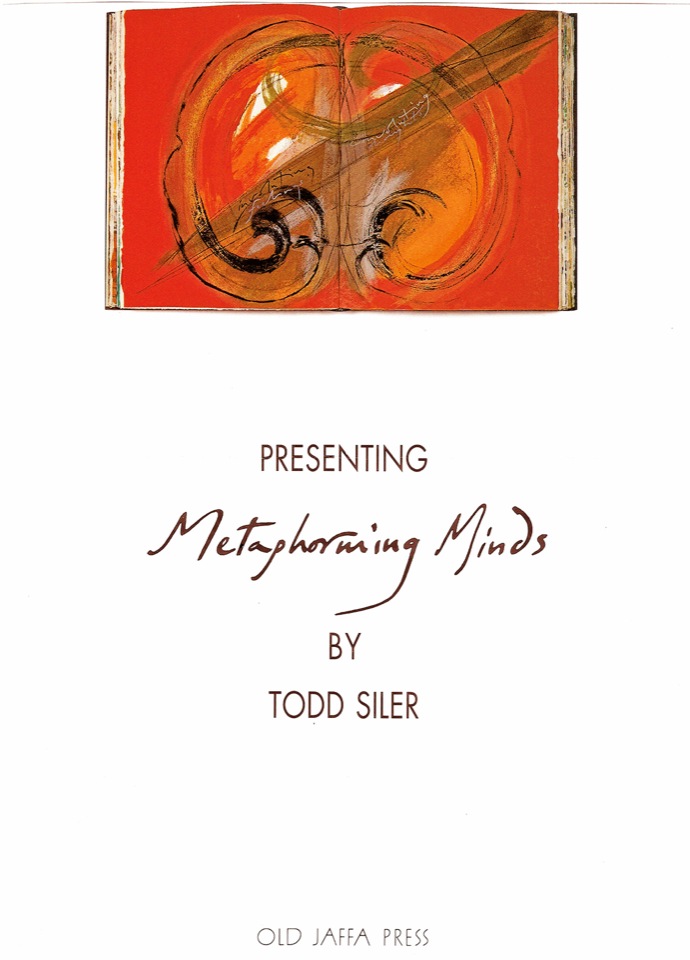
“We all know that the human brain creates many marvellous and menacing things, but Siler's work transforms this fact into an idea of great consequence. He manages to evoke in us a palpable sense of horror at the possibilities of imagination, as well as an equal sense of wonder at the strange and delicate operations within the mind…Siler's drawings and paintings do not suggest some a priori reality…He depicts through a recursive and additive vocabulary what others are just now attempting to describe.”
— Patricia C. Phillips, art critic for Artforum
In Metaphorming Minds, Todd Siler poetically integrates many fields of knowledge and perspectives, exploring the workings of the human mind. Through his allusive images and evocative writings, Siler interrelates the workings of the brain and its creations. His extraordinary art illuminates how these deepest relationships are critical for understanding our evolution, humanity and survival.
Metaphorming Minds is a multi-part work of art I created in 1991-92 in Old Jaffa, Israel. This collection of 37 hand-bound monotypes forms the foundation of this portfolio of multi-colored serigraphs was created during two of the most intense years in the history of the Middle East. When I embarked on this journey in January 12, 1991, threats of ss-1 Scud missile attacks on Tel Aviv jolted not only that raw region of the world, but also the fragile future of modern civilization. The visual notes, called “Possibilities,” that fuel this soulful artwork are silent meditations on the ever-anxious state of the world. They prompt us to wonder where our global tribes of minds are heading in such a hurry, as we race towards an uncertain destiny. Here, the history of art mirrors the history of thought. And in this mirror reflection, we glimpse our collective preoccupation: groping to manage the ultimate “essential tension”—our conflicting passions for love and power.
This limited edition portfolio consists of 37 multi-colored serigraphs on Arches 300gm paper, each 16 in. x 24 in., hand-pulled in collaboration with the artist. Integrated with some of the images are 20 collaged reproductions. Also, behind a select group of images are hand-written notations on the “Possibilities” of the human mind and its hidden potential.
In 1993, Metaphorming Minds, Old Jaffa Press, 1991) won the Gold Medal Award for "most exceptional artist's book and portfolio of prints" at the International Book Fair, Jerusalem. In 1991, the Israeli filmmaker Ayelet Heller, produced a piece for Israel National Television, “The Art Work of Todd Siler.” The program documented the creation of "Metaphorming Minds" at Har-El Printers and Publishers in Old Jaffa, Israel.
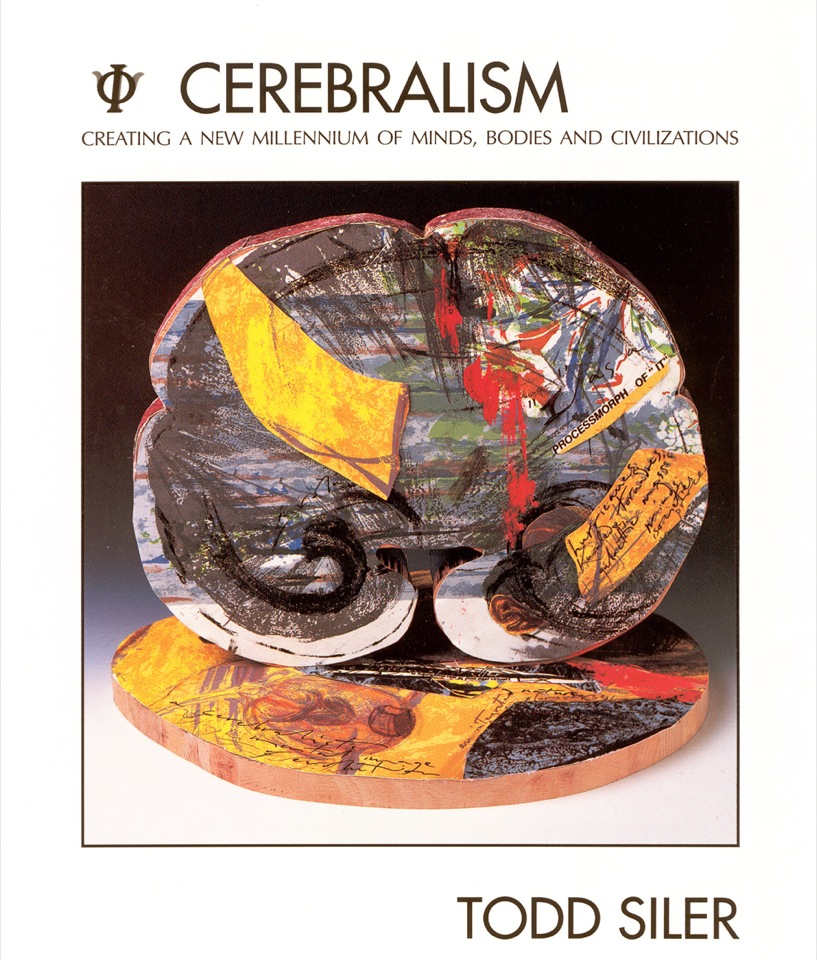
The culmination of Siler’s thinking to date is reflected in Cerebralism: Creating a New Millennium of Minds, Bodies, and Civilizations. Cerebralism was published in conjunction with Siler’s fifth solo exhibition at Ronald Feldman Fine Arts, “Radical Futures” (1993).
“Siler…invents…Cerebralism for the purpose of breaking the mind barrier set by the functional education. To him, cerebralism does not end with the brain, the nerve system or the spinal cords…Cerebralism is about mind. It is the mind in whole and the whole of what the mind can do. Further, the creation, reflection, and affection of the mind is one with the universe. Thus Siler intends to adopt art as a channel to communicate with different fields of knowledge and hence to break the mind barrier and enable the full development of ‘Metaphorms.’”
— Kuang-nan Huang, Director, Taipei Fine arts Museum
On July 25, 1989, the United States Congress declared the 1990's the 'Decade of the Brain.' This declaration was made largely in recognition of the fact that at the heart of all our actions and creations is the human brain. The artworks in this publication consider ways we can use use the arts to integrate all forms of information, knowledge and experiences, in order to creatively see the unity of nature in highly practical and purposeful ways. Cerebralism explores the “connectedness” of the world—from the forces that that bind atomic atomic nuclei to the forces that unleash our brains’ creative potential.
This art catalogue accompanied Siler's solo exhibition, “Radical Futures,” at Ronald Feldman Fine Arts, New York City, February 27 - March 27, 1993
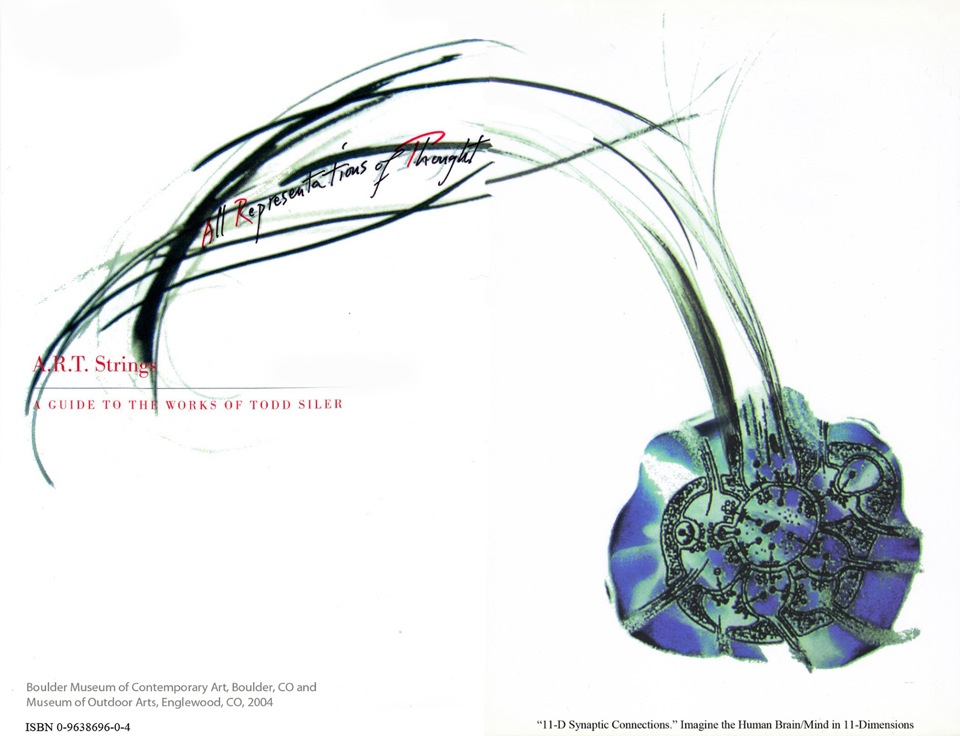
“All meanings are hidden, in the image, in the language, in the equation, no matter how obvious and open they may appear to be...The photo aluminum sculptures Todd Siler put up in the center of the gallery, dated 1975-2004, are clustered like a forest of obelisks—a cemetery—that constantly get in our way and convey changing meanings as we move through and around them. They twist and turn in space, like Brancusi's Bird in Space, revealing images distorted, at the edge, as we, moving through the world, and the universe, see them out of the corners of our eyes, and our brains. One place melds with another. On the back of a soaring fragment of Munch's The Scream is a tangential scene of Explosions of Infinite Dimensions. Behind the New York Stock Exchange is Nuclear Cooling Towers. Bound to Sweating Mosquito Life is The Deep Taproots of Global Terror. Different kinds of connective meanings--emotional, cosmic, political, biological—all made physical.”
— Donald Goddard, “Conrad Atkinson: Collaborations & Todd Siler: A.R.T.Strings,” New York Art World, Feb. 2, 2005; www.newyorkartworld.com/reviews/atkinson-siler.html
A.R.T. Strings had its inaugural exhibitions at Boulder Museum of Contemporary Art (September 9, 2004 – January 16, 2005) and Ronald Feldman Fine Arts in New York City (December 2- 24, 2004). This multi-part installation features a series of mixed-media paintings on synthetic canvas (“Metaphorms”) and freestanding steel sculptures (“Subliminal Stories”) with manipulated reproductions of artist-made and media originated images that depict a world of information we experience daily that is radically shaping the future of life as we know it. The collective imagery transforms icons of urgent global issues and challenges affecting every facet of contemporary life and the evolution of art-science-technology, and society.
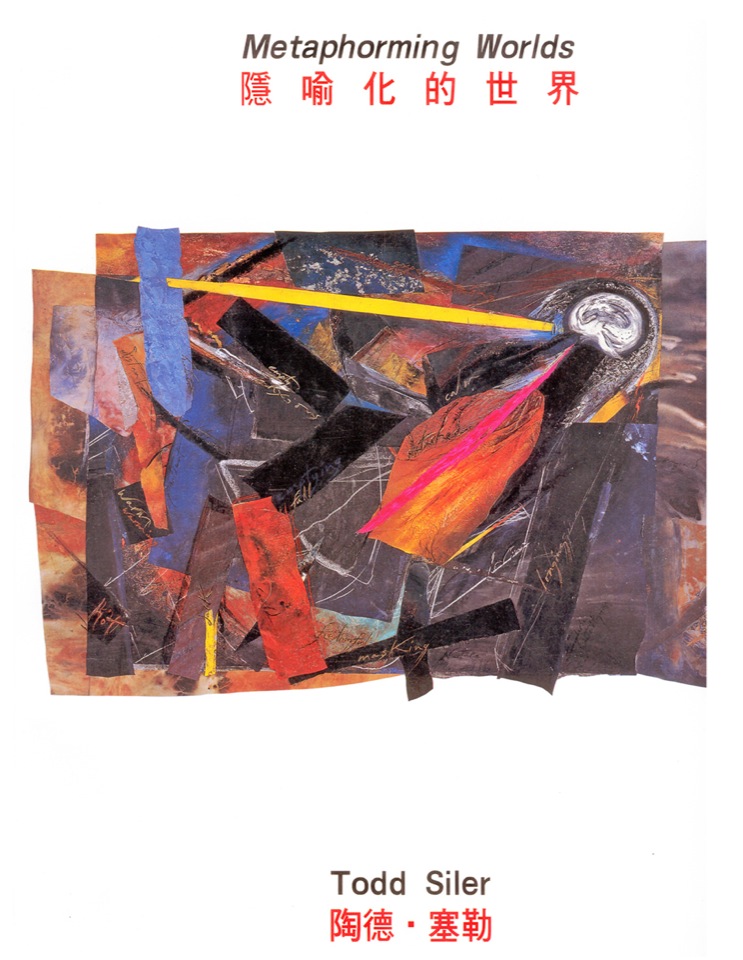
“These works represent [Siler’s] thinking and feeling processes. Siler…elevates the viewer’s thought into another level…While reading Siler’s metaphorms, audience will be able to decipher their inner feelings and thoughts. And by conceiving others’ mental processes, one also learns to comprehend better his real self.” — Kuang-nan Huang, Director, Taipei Fine arts Museum
“Todd doesn’t just paint pictures that integrate fields such as art, science, and politics; he doesn’t just talk about integrating; he actually lives integrating. The science in his pictures isn’t there just as a subject or an icon, as it is in so much art about science. The science in Todd’s pictures is there because it has to be. The art is science, and the science, art—artscience and scienceart, to use Todd’s neologisms.
In fact, one could easily think of Todd’s art as one neologism after another, but made by combining the disciplines of art, science, and philosophy. Indeed, the neologism, be they his verbal creations or his visual ones, emerge out of the necessity of finding a new language for discussing how things are linked within a vocabulary that has been almost completely shaped by making distinctions between things. If some people have problems understanding his new language, it only proves how ingrained this divisive analyticism has become, and consequently, how difficult it is for most people to see over the barriers that their education has erected between them and every aspect of existence. Todd, in short, for all of the incredible scope of his images, does not use science or engineering as arcane symbols to overawe the uninitiated or to impress the gullible—he uses all of his knowledge for the purpose of creating understanding.”
— Dr. Robert S. Root-Bernstein, “Todd Siler: Exploring the Possibilities of ‘Art as Science’,” Metaphorming Worlds (Taipei Fine Arts Museum, 1995);
Dr. Root-Bernstein is a physiologist, science history, MacArthur Prize Fellow, and co-author of Sparks of Genius (2000)
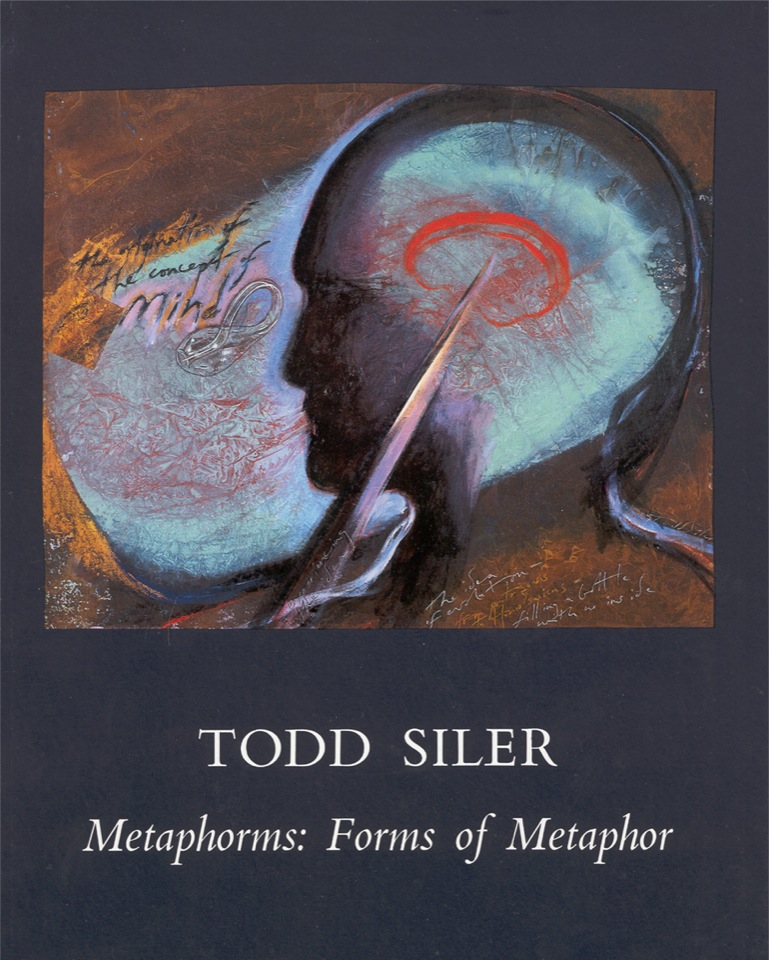
“Todd Siler is exploring the difficult and mysterious terrain where symbol and form meet. This area represents one of the last uncharted frontiers of science and, equally likely, one of the first artistic and philosophical pre-occupations of man....Since neuroscience is in a very early stage of development, there is ample room for the kind of visionary approach that Todd’s work represents...There is much historical precedent for the intuitive, esthetic, and pre-rational to play an important role.”
— Eric L. Schwartz, neurophysiologist at New York University School of Medicine and Adjunct Associate Professor of Computer Science at the Courant Institute of Mathematical Sciences, New York University
“Through the use of the metaphorm as described by Todd Siler, physics can be projected into other disciplines and consequently, the unifying principles of physics can also be projected into other disciplines...[Siler’s] vision of the advantages of metaphorms was that they would extend our understanding of reality.”
— Louis M. Houston, author of Metaphorms and Information Physics
Metaphorms encompass all forms and expressions of metaphor, analogy, simile, signs, symbols, stories, allegories, figures of speech, euphemisms, puns, portmanteau words, premises, hypotheses, theories, and models. They are universal connection-making devices that we use all the time to convey our thoughts, feelings, emotions, opinions, ideas, knowledge, and experiences. Moreover, they're the fuel and power source for the human brain's creative engine of innovation.
Metaphorming is the act of connecting and transforming metaphorms. From Siler's art we glimpse how everything in the built and natural environment is a metaphorm.
This book explores the nature of metaphorms, a term Siler coined in the mid-1970s to describe the versatile connection-making process every human being uses in one form or another to communicate. Metaphorms enable human communication and enhance understanding.
Siler’s solo exhibition, Metaphorms, was presented at The New York Academy of Sciences, New York, NY (September 28 - November 28, 1988) and The Chicago Academy of Sciences, Chicago, (December 16, 1988 - March 19, 1989)
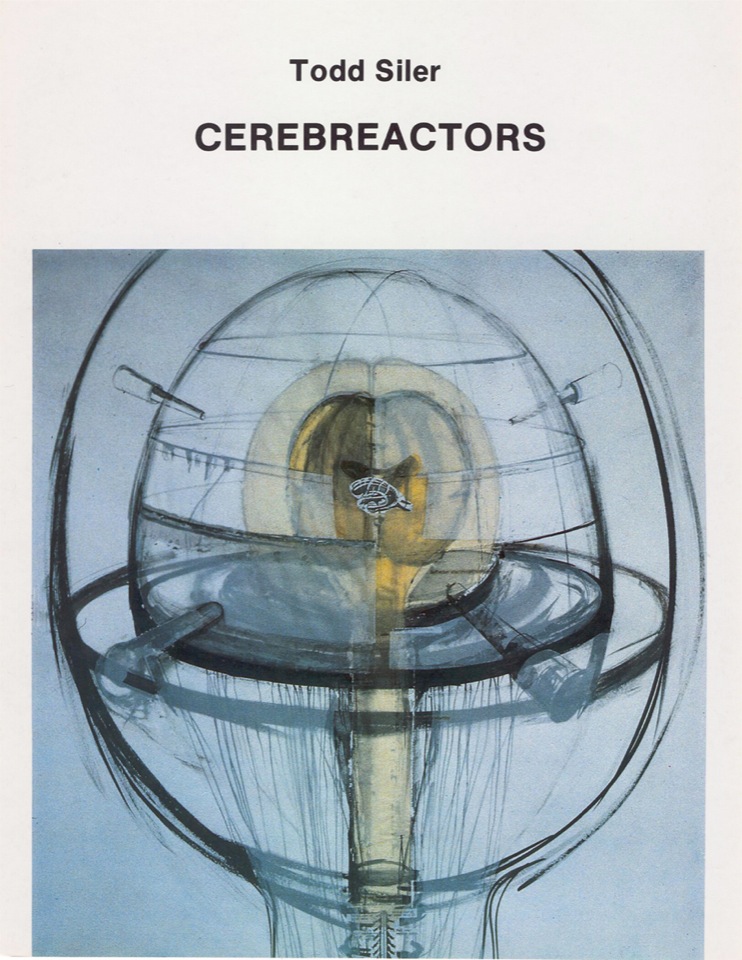
“Twenty-eight years old, Todd Siler is having a great deal of fun remapping the boundaries between the aesthetic and the cerebral cortex. His work ranges from classical pen-and-ink sketches to complex technological constructions....Cerebreactors are surrealistic models of the mind: depictions of the human nervous system as an organic linear accelerator, with the spinal cord as conduit and the brain as a reactor chamber, where subatomic particles tumble into energy fields that shape the pattern and substance of thought.. Nuclear physics becomes Neurophysiology. Cerebral fission, he says, is analytical reasoning; cerebral fusion is intuition.
‘The model is a mathematical equation,” says Siler, who holds a Master of Science degree in visual studies from MIT. ‘Various parts of the construction explain the workings of both systems without being either of the two. For example, the copper rods represent the amount of electrical activity; the graduated cylinders represent the chemical activities.’
Siler’s art is as much a part of his research as it is a means of visual expression....The art itself appears as fantastical blueprints. The various parts of a Cerebreactor are carefully labeled and described. Photographs, aluminum foil, string, and plastic wrap are occasionally collaged across a canvas. The effect is a casual textured image of something that looks like it might exist. Cerebreactors seem to be technology and tissue all at the same time...There’s no question that they are rough cuts in the process of being refined to a more precise portrayal of brain and mind...He seems driven to push the art of technology and the technology of art into convergence.”
— Michael Schrage, “The Arts,” OMNI, October 1982, p.38
Cerebreactors (New York, NY: Ronald Feldman Fine Arts, 1981) is part of Todd Siler’s Masters of Science in Visual Studies (Thesis), titled “Reality” (Cambridge, MA: Massachusetts Institute of Technology, 1981).
It includes essays by Carl Malbrain, Nuclear Engineering (MIT), Robert Lawrence Kuhn, Neurophysiology (UCLA) and Psychology (MIT), and Shai Haran, Pure Mathematics (MIT).
This publication accompanied Siler’s solo exhibition, “Top Secret: Inquiries Into The Biomirror,” Ronald Feldman Fine Arts, New York, NY, (March 14 - April 16, 1981).
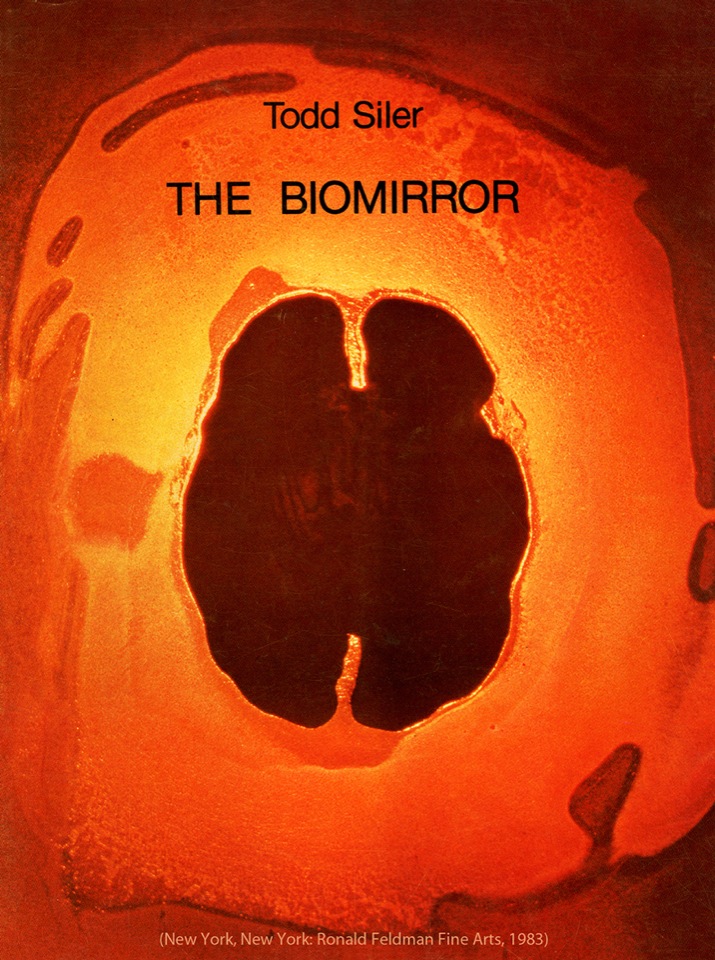
“Todd Siler turns the stimuli of artistic invention in upon themselves by investigating and representing the brain that does the investigating and representing. I know of no work since the Renaissance in which the concerns of figurative art and of investigative science come closer together than the dye in Siler’s drawings, assemblages, and sculptures. They are advanced research and at the same time objects of vigorous formal quality. They demonstrate to empirical scientists the potential of model and metaphor, and they point a way for the artist of the later twentieth century to regain for visual art its historical integration with contemporary life.”
— James S. Ackerman, Arthur Kingsley Porter Professor of Fine Arts, Harvard University, author of Palladio (1974) and Leonardo da Vinci: Art in Science (1998) From the Foreword to Todd Siler, The Biomirror (New York, NY: Ronald Feldman Fine Arts, 1983)
“Todd Siler has been producing an awesomely rich and varied corpus of paintings, drawings, collages and other works which embody and express some exciting and completely original ideas about the material and conceptual connections between the arts and sciences. It is difficult for me to exaggerate the influence that my association with Todd Siler has had on my perception of my own field and its relations to the larger world of human affairs of which it is part. I believe him to be that rarity among us: a person whose thoughts and feelings and actions seem destined to make a real difference; one whose contributions to human understanding serves simultaneously to reflect and reinforce the creative process which is the means and the end of self-conscious human existence in the biosphere.”
— Dr. Stephan L. Chorover, Professor of Psychology and Brain Science at MIT (From the Foreword to Todd Siler, The Biomirror. New York, NY: Ronald Feldman Fine Arts, 1983)
The Biomirror accompanied Siler's solo exhibition, “Thoughts / Thought-Assemblies,” at Ronald Feldman Fine Arts, New York, NY (September 10 - October 8, 1983) This catalogue includes a short videotape, Cerebreactors: Inquiries Into the Biomirror (12 minutes), directed and edited by Matthew Kallis and Gregoria Rivera.This videotape documents Siler's interpretive drawings, assemblages, and three-dimensional constructions, exploring the nature of mind and thought processes.
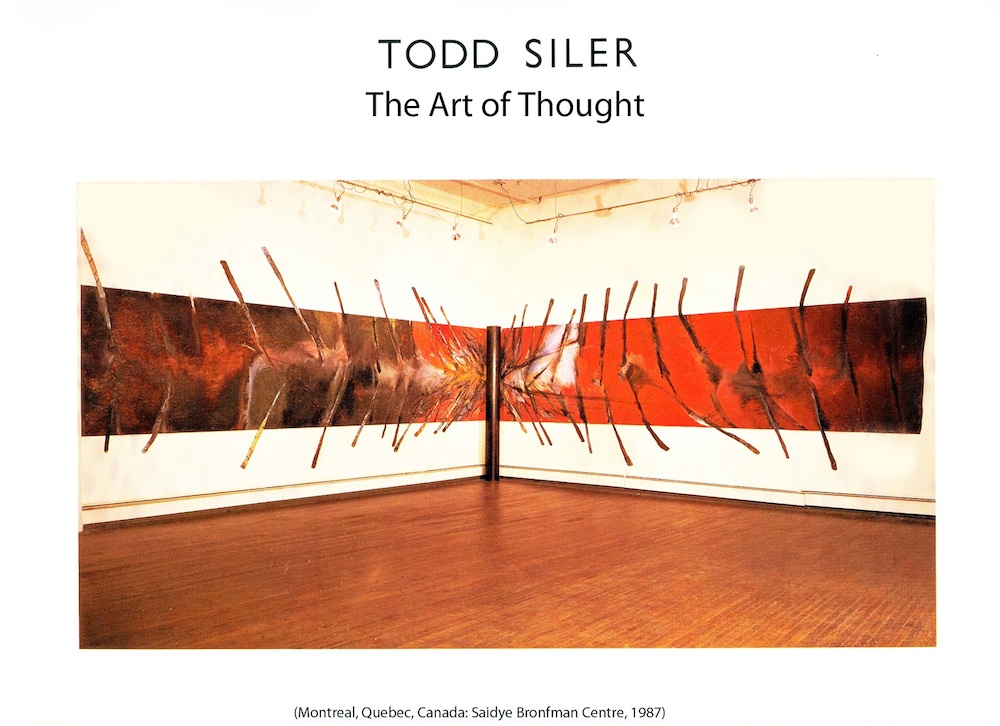
“We all know that the human mind creates many marvelous and menacing things, but Siler’s work transforms this fact into an idea of great consequence. He manages to evoke in us a palpable sense of horror at the possibilities of imagination, as well as an equal sense of wonder at the strange and delicate operations within the mind. The world does not exist independent of human cognition or symbolic activity. Siler’s drawings and paintings do not suggest some a priori reality. He makes the Harvard psychologist Nelson Goodman’s idea of “world-making” visually concrete. He depicts through a recursive and additive vocabulary what others are just now attempting to describe.”
— Patricia C. Phillips, Artforum
“Aesthetically, his work can enrapture the senses by the expansiveness of its scale, the poetic awesomeness of its subject matter, the delicate contours of its abstract choreography, and the mysterious nature of its strange visual alphabet…Siler fills his images with nervously drawn, concise sentences, which disappear at a distance. Conversely, when the viewer approaches the canvas, the linguistic dimension reveals itself and also signals an important change in the relationship between the work and the spectator. As one journeys into the image, picking up meaning from cryptic aphorisms, one slowly enters Siler’s own mind and abandons the comfortable, disinterested posture of normal perception to become a reader and a thinker. Siler is therefore not simply an image-maker, but a theoretician, a poet, and a dreamer. Siler, like Hermes, enjoys traveling everywhere: in formal and applied sciences, in literature, in art and in the difficult and delicate regions where they all connect or separate.”
— Phillip Evans-Clark, “Psi-Phi: Hidden Territories,” at Ronald Feldman Fine Arts,” Tema Celesta
“…Siler’s works most often take the size of wall-size gestural paintings on unstretched synthetic canvas a material with a scientific resonance because it is used for protective clothing in the nuclear industry. The paintings are frequently collaged, drawn on and casually notated as if circumstantial evidence of thinking were more important than formal concerns. In Boston, the Boston Center for the Art’s cavernous round Cyclorama building – itself a “metaphorm” – allowed Siler to unfurl his longest mixed-medium paintings [100-foot arcs], “Thought-Assemblies” and “The Brain Theater of Mental Imagery…His works drew on his concepts of “metaphorming,” or the creation of metaphors that enable us to relate information from one discipline to another, and “processmorphs: things that are alike in process but unlike in form or appearance.’ He asserts that the brain reflects the universe in function and form and that we become what we think about and create.”
— Ann Wilson Lloyd, “Todd Siler at Ronald Feldman Gallery and Boston Center for the Arts,” Art In America (April 1991)
“Through his drawings, collages, markings, and writings, Todd Siler presents us with an open work in which the spectators’ eagerness to decipher the different levels of interpretation is sustained by a strange power of seduction which gives the work its strength and metaphorical quality. It is a clash of pleasure and a fear of emptiness. There is in his work the lure of light following the passages through darkness.”
— Claude Gosselin, Director of the Centre International d’Art Contemporain de Montreal